Chinese Dry Spices and Seasonings is a big category, with ingredients you won’t find in your average spice aisle.
On this page, we’ve made a small dent in the vast number of spices used in Chinese cuisine. We’ve listed the ones we use most often in our kitchen. If you don’t see what you’re looking for, give us a shout in the comments below. We’ll do our best to help!
If you’re looking for a different ingredient, type it into the website search bar. Or check our main Chinese Ingredients Glossary page to peruse other categories!
Below, you’ll find a short description of each ingredient, as well as a ‘Read More’ link to a more in-depth article, if available. We recommend clicking on the in-depth articles if you have time. They talk more about how we use the ingredient, buying and storing it, etc.
Basics
Peppercorns & Chilies
Blends & Powdered Spices
Dried Whole Spices & Seeds
Miscellaneous
Salt (盐, yán)
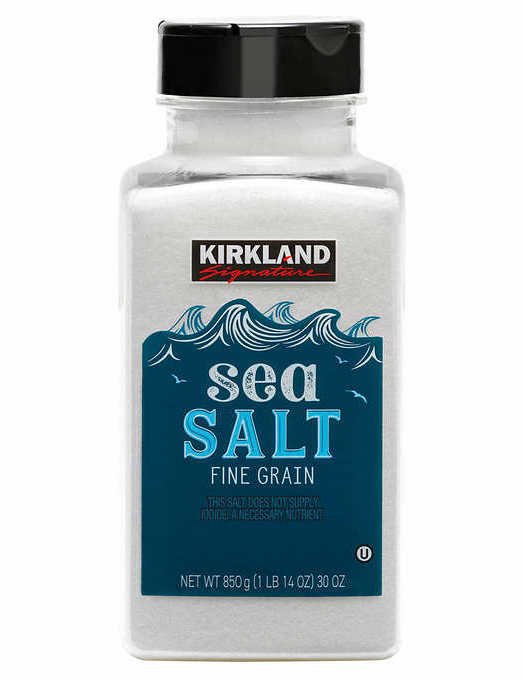
Salt is a foundational seasoning in cooking all over the world. That said, we do have a preference. For Chinese recipes, we cook almost exclusively with fine grain sea salt, which has a pure flavor, dissolves readily into sauces, marinades, etc. and doesn’t have anti-caking agents added to it (like table salt). The grain size affects the amount of salt you’re adding by volume; fine grain salt has fewer air pockets than say, kosher salt. To replicate our recipes, use fine grain sea salt for accurate results!
Depending upon the type and region of the dish you’re cooking, you may also use soy sauce or other sauces as your primary source of saltiness. For example, Shanghai dishes use soy sauce liberally, so less salt is used in those recipes than in say, Sichuan, Cantonese, and Northern Chinese cooking, where it’s the other way around (more salt, less soy sauce). If you’re sticking to a low-sodium diet, the beauty of cooking at home is that you have the option to adjust the amount of salt used, and you can enhance your dishes in other ways!
Sugar (糖, táng)
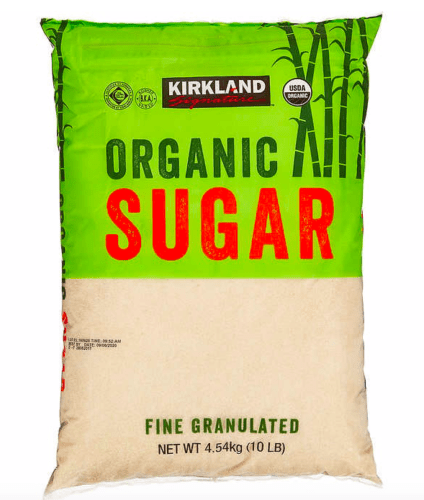
In Chinese cooking, you’ll see a very small amount (say, a quarter teaspoon to one teaspoon) added to stir-fries, marinades, and sauces to balance out salty and sour flavors. You may see that in certain sauce mixtures, we call for hot water or chicken stock. The purpose of that is usually to quickly dissolve any sugar that might be in the mix. We like using organic sugar, though we also use regular white granulated sugar for some baking applications.
Rock Sugar (冰糖, bīngtáng)
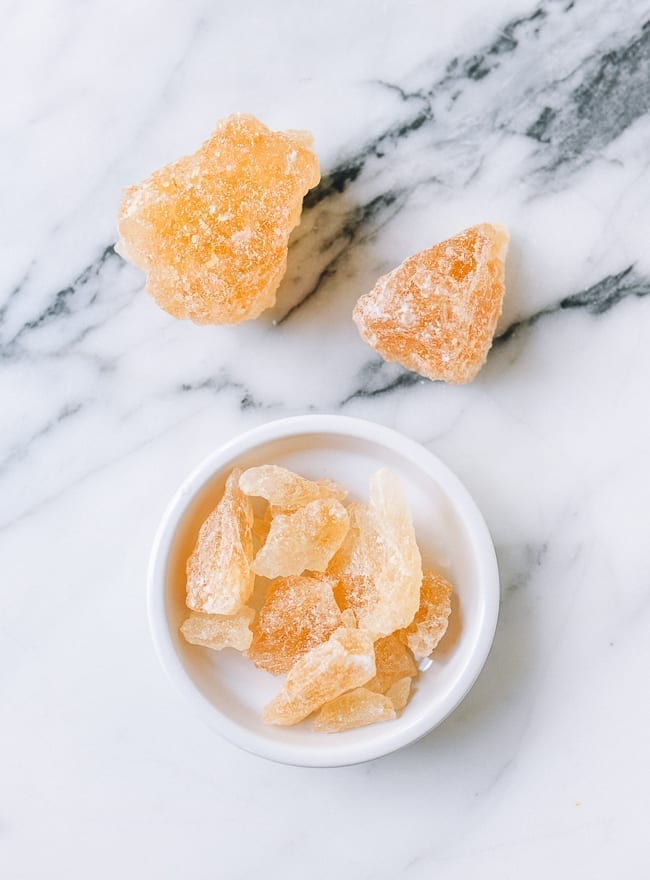
Rock sugar looks a lot like rock candy. (That’s basically what it is!) It ranges in color from white to amber, depending on how much of the molasses has been left in it. For braised dishes like Judy’s Shanghai Braised Pork Belly (Hongshao Rou), you’ll usually melt the rock sugar in oil over medium-low heat until you get an amber brown liquid. If you can’t find rock sugar, you can substitute brown sugar or granulated sugar. For more details on rock sugar, visit our detailed article on How to Use and Store Rock Sugar.
Brown Rock Sugar Wafers (冰片糖, bīngpiàn táng)
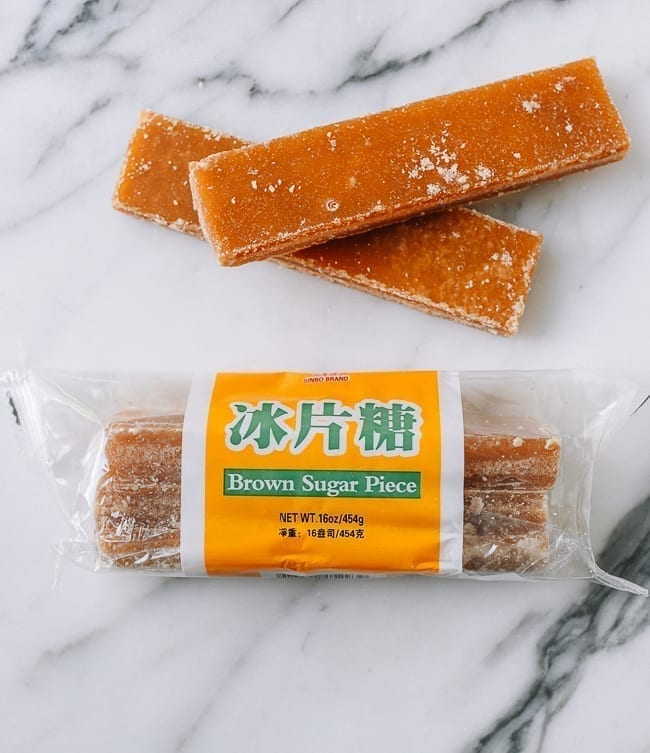
You can also get brown rock sugar wafers, which are like thin bricks. This type of rock sugar generally has more molasses in it than regular rock sugar, which is why it has a rich brown color. When we call for it in a recipe, you can cut pieces of it with a knife and weigh it using a digital kitchen scale to ensure you have the correct amount. In our recipes, use it interchangeably with regular rock sugar (above). Read more about it here.
Caster Sugar (沙糖, Shā táng)
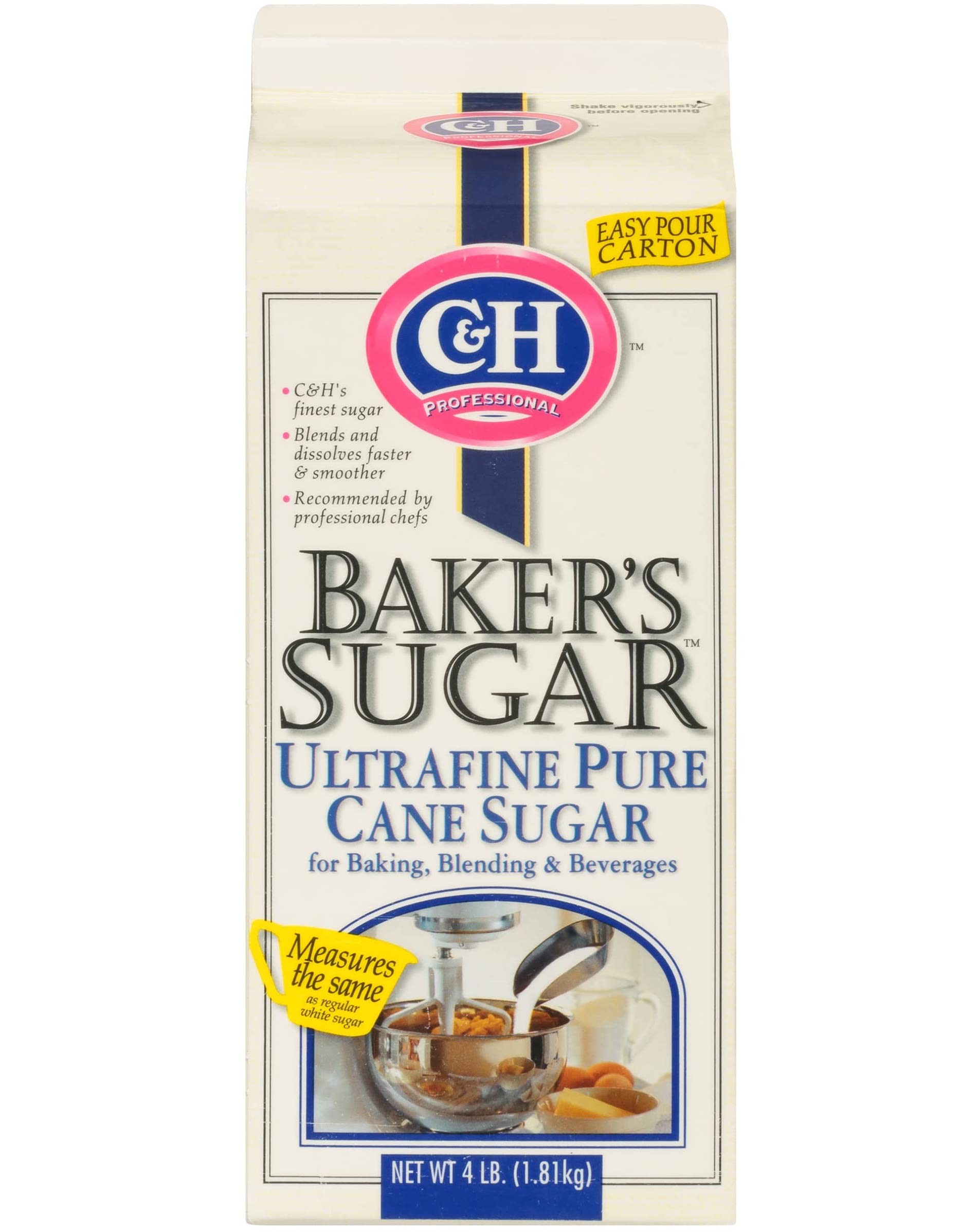
Caster sugar (the U.K. term) or superfine sugar (U.S. term) is known as shā táng (沙糖) in Chinese, or literally “sand sugar.” It falls somewhere between granulated and powdered sugar. It’s hard to find, but if you have a food processor or a good blender, you can actually make it yourself. Just place granulated sugar in the processor or blender and whizz it until it gets to a fine but not powdered state. You’ll need it to make Coconut Cocktail Buns and Pineapple Buns!
MSG (味精, wèi jīng)
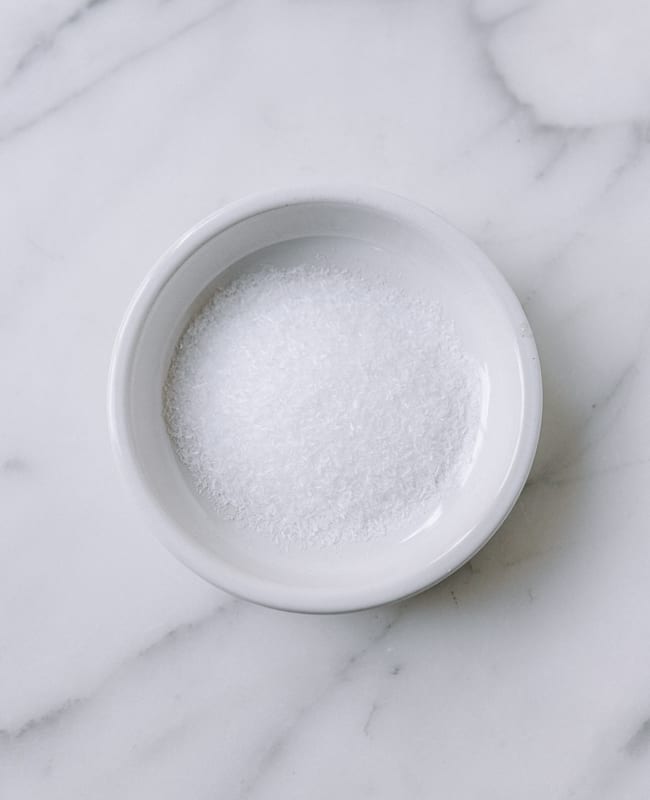
MSG, or monosodium glutamate, has a bad rap, but we see it as a tool you can try in your cooking if you’re open to it. It’s an isolated compound that’s naturally found in kombu (dried kelp), tomatoes, and parmesan cheese. When used as a flavor enhancer, it intensifies the savory taste of foods (i.e. umami, the 5th taste). We don’t use it often, but we include it in a few recipes where we think it takes it the extra mile. Read more about our stance on MSG here.
White Pepper (白胡椒, bái hú jiāo)
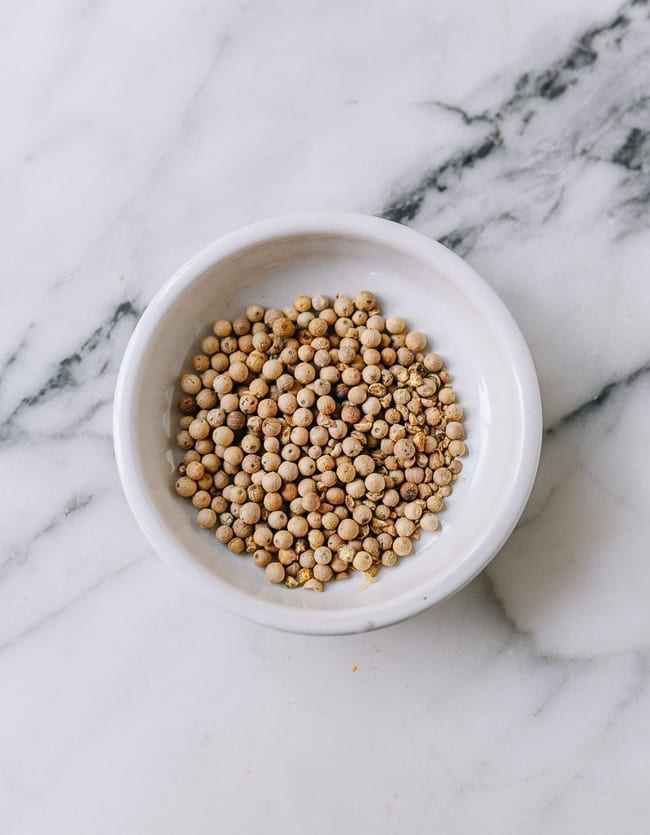
The white peppercorn has a distinctly different taste than black pepper—more of a pure heat that goes straight to the back of the throat…with less of that floral fragrance you you get from black pepper. It is always the preferred choice for Chinese cooking unless otherwise specified. A little-known fact is that white and black pepper both come from the same plant. We often use finely ground white pepper powder but sometimes use it freshly ground or as whole peppercorns.
Red Sichuan Peppercorns (红花椒, hóng huā jiāo)
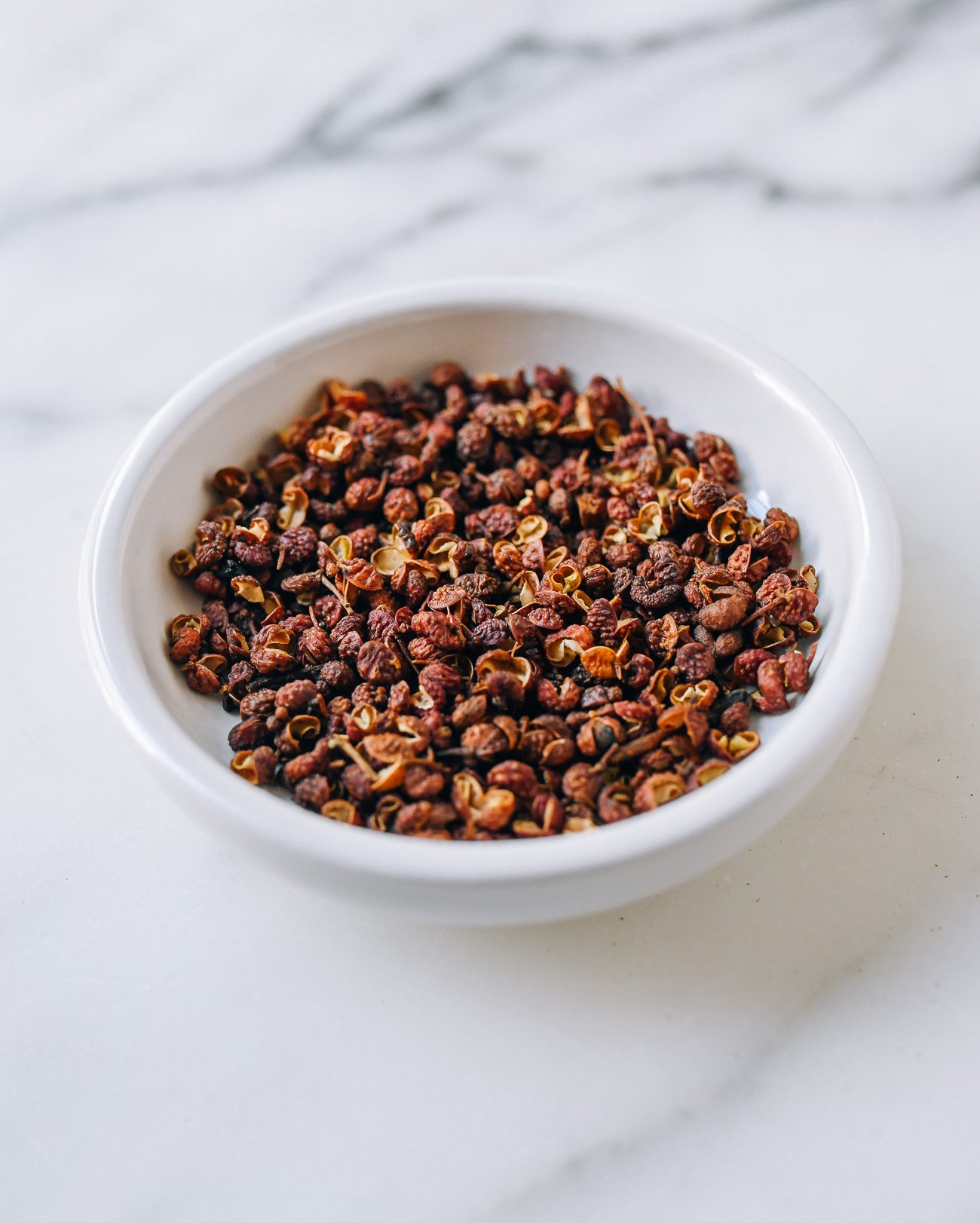
Known for the numbing sensation it leaves on the tongue, the Red Sichuan (Szechuan) peppercorn or hóng huā jiāo (红花椒) gives Sichuan cuisine its distinctive flavor. It’s actually not a peppercorn at all, but a berry from the prickly ash tree. It’s used both whole and ground, and is one of the ingredients in five spice powder. The red variety is most common; they should be vibrant, with just the husk (no bitter black seeds). Find high quality Sichuan Peppercorns at The Mala Market.
Green Sichuan Peppercorns (青花椒, qīng huā jiāo)
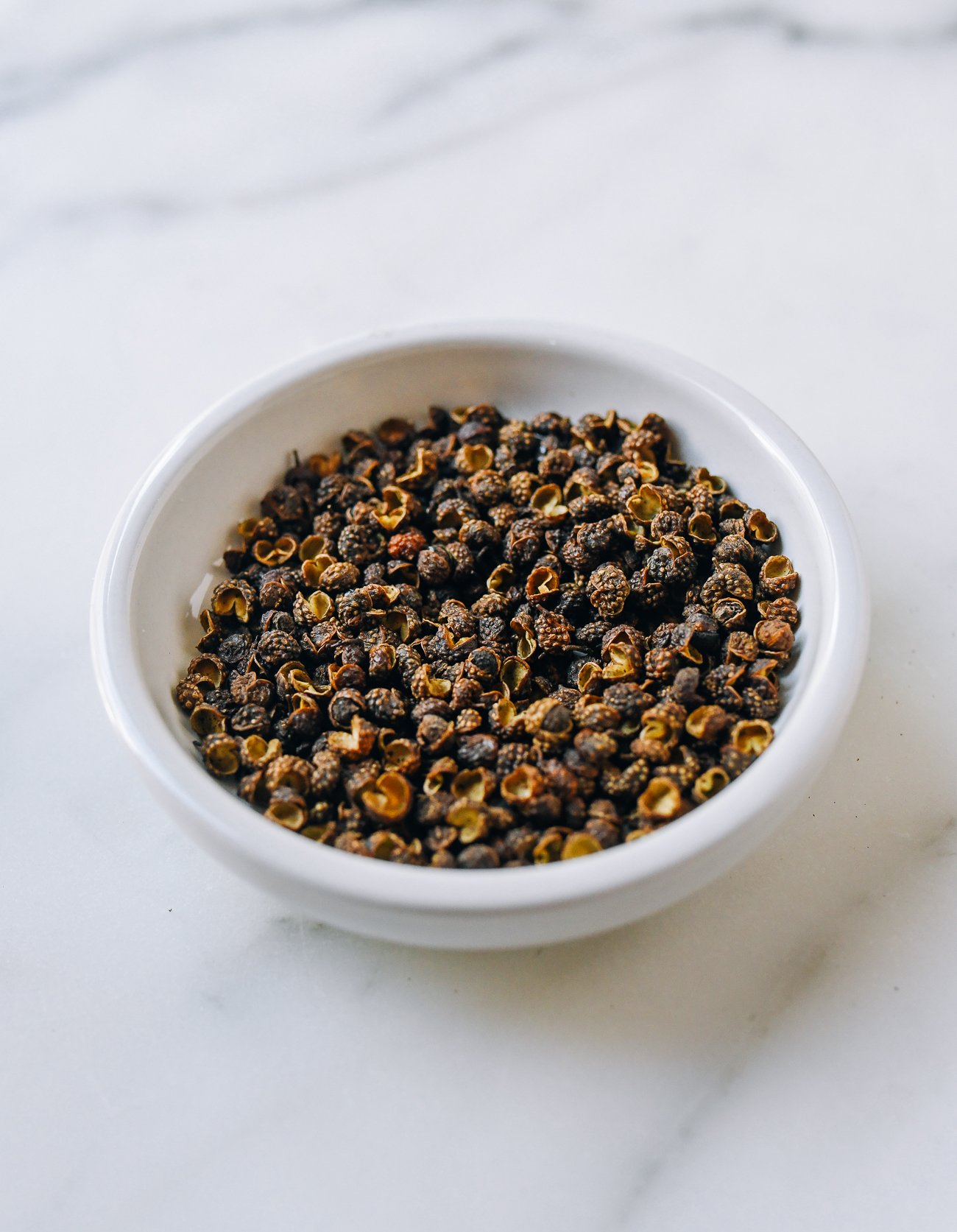
Green Sichuan peppercorns are much stronger than the more common red Sichuan peppercorns (above). Green Sichuan Peppercorns have a stronger aroma and retain their green color after drying. Good quality green Sichuan peppercorns should have a rich color with little or no stems and dust. Once opened, you will smell their flowery fragrance. Keep them in a sealed plastic bag or a sealed jar, and use them often so they are fresh!
Sichuan Peppercorn Powder (花椒粉, huā jiāo fěn)
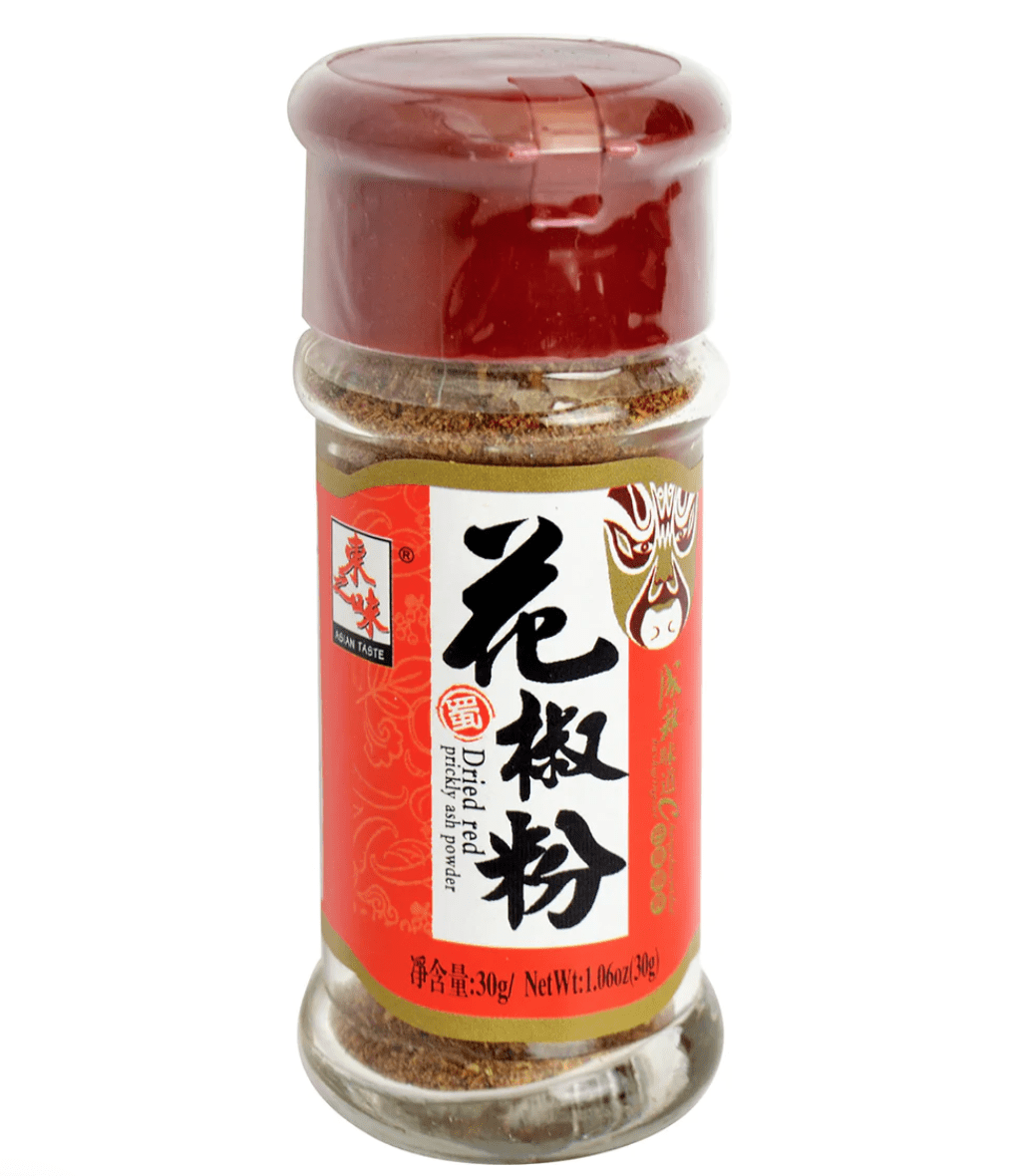
Sichuan peppercorn powder, or huā jiāo fěn (花椒粉)…also called huā jiāo miàn (花椒面), is a convenient way to add a dash of Sichuan peppercorn flavor to recipes. It’s a good solution if you prefer not to use whole Sichuan peppercorns in your dish. That said, for the freshest flavor, you can grind your own Sichuan peppercorns in a mortar and pestle or spice grinder.
Sichuan Chili flakes (辣椒粉, làjiāo fěn)
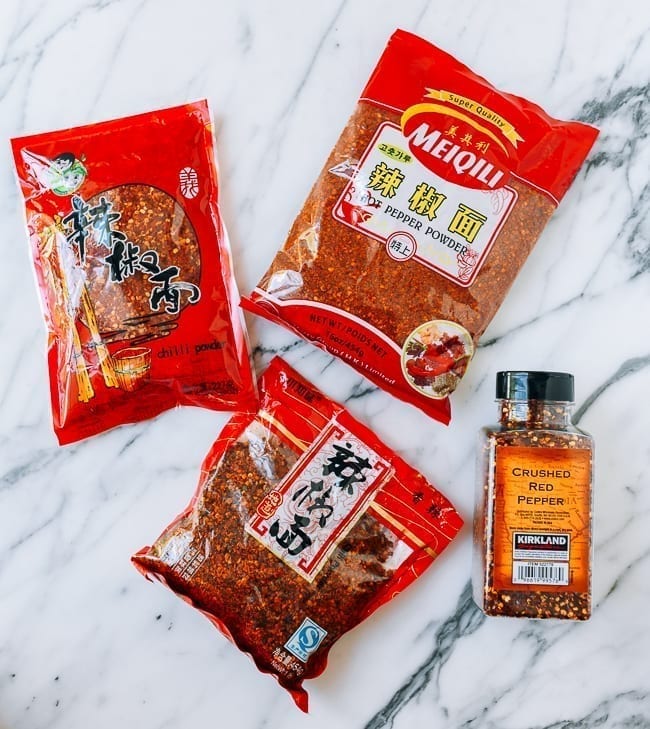
Sichuan chili flakes are crushed but not fully pulverized—perfect for making chili oil. There is some powder and some crushed pieces, the perfect texture for chili oil and adding to sauces and dry rubs. Check out The Mala Market for authentic imported Sichuan chili peppers, including chili flakes. Avoid using regular crushed red pepper flakes (also pictured), which are generally spicier with less depth of flavor.
Dried Chili Peppers (干红辣椒, gān hóng là jiāo)
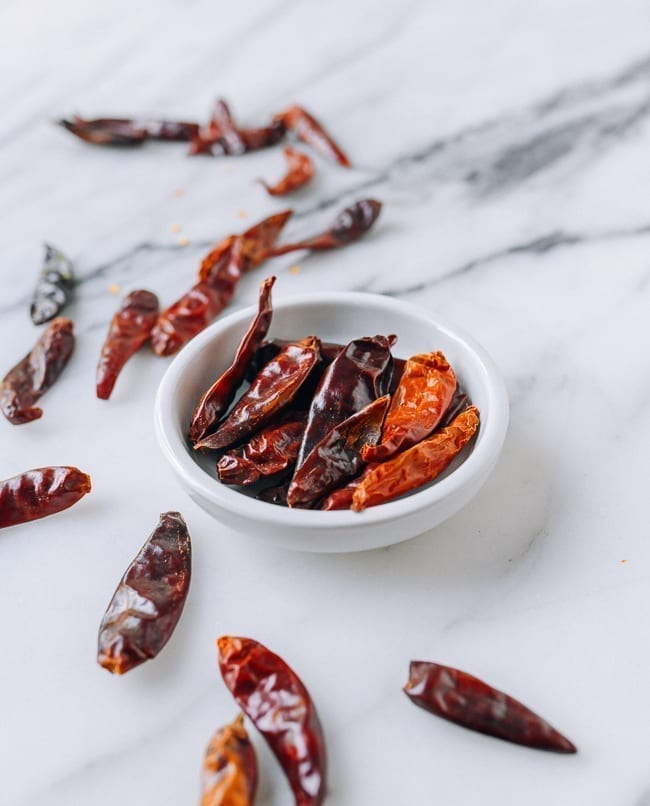
Dried Red Chili Peppers or gān hóng là jiāo (干红辣椒) come in a number of varieties. In general, the smaller the chili, the hotter they are. We use dried chilies in many of our recipes, whole or cut into pieces. When toasted properly, they are pleasantly fragrant and tasty! We add just a few for a toasted pepper flavor with a hint of heat, like in our Orange Chicken. Sometimes we add more for extra spice, like in our Eggplant with Garlic Sauce.
Korean Chili Powder (Gochugaru)
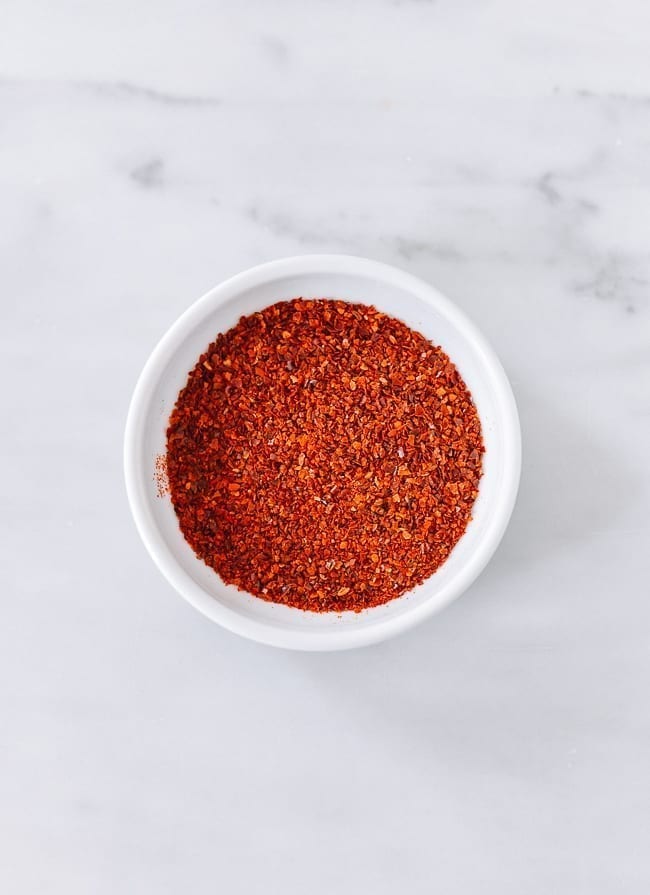
Korean chili powder, or gochugaru, is sweet and spicy with a hint of smokiness. We use it in our Korean recipes, like our Soondubu (Soft Tofu Stew), Kimchi Jigae, and Kimchi Beef Fried Rice. It’s a key ingredient in kimchi and adds a vibrant red color to whatever its added to. You can use it in larger quantities, as it’s somewhat mild. Find it in Korean markets, other Asian grocery stores, online, and in the spice aisle of some well-stocked supermarkets.
Five Spice Powder (五香粉, WǓXIĀNG FĚN)
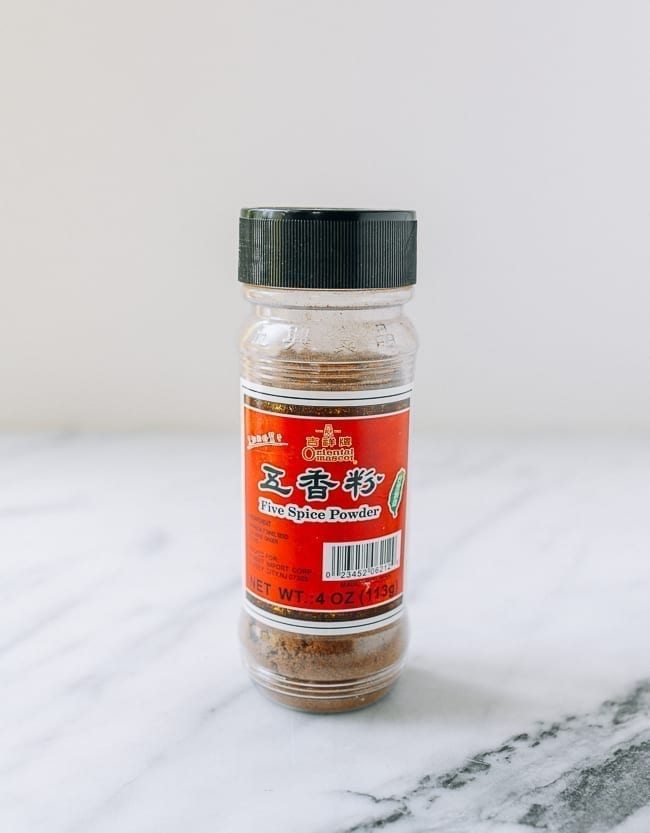
This famous five spice mixture or wǔxiāng fěn (五香粉) is usually made from Sichuan peppercorns, fennel, cloves, star anise, and cinnamon, but the spices can vary depending upon the brand. The blend combines the five primary flavors of Chinese cuisine: sweet, sour, pungent, bitter, and salty. It is widely used in Chinese cooking—usually for marinades and dry rubs for meats. It’s sometimes set out on the dinner table mixed with salt and white pepper as a condiment for chicken dishes.
Curry Powder (咖喱粉, gālí fěn)
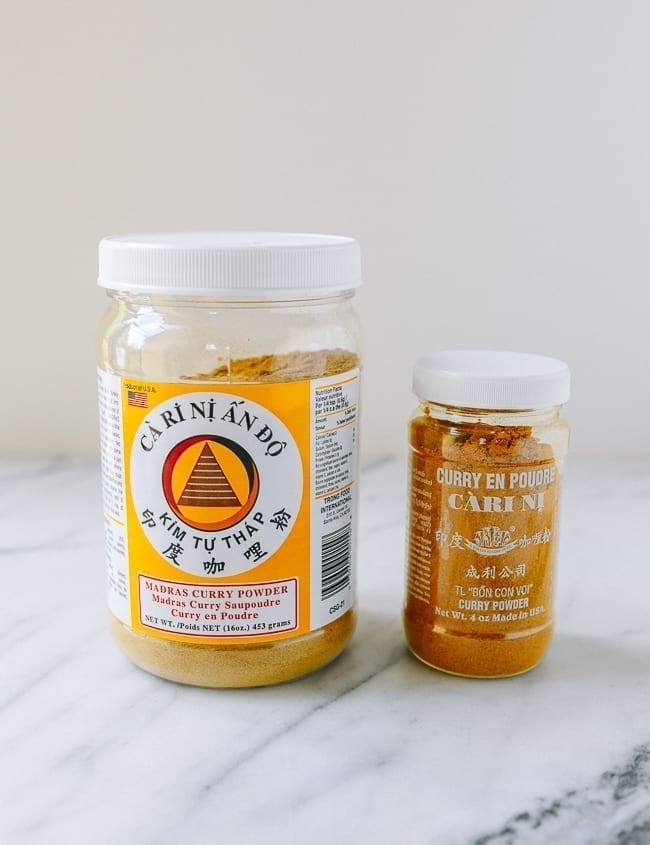
Curry powder or gālí fěn (咖喱粉) is a spicy powder made by blending spices like turmeric, cardamom, cinnamon, cumin, cloves, fenugreek, chili peppers, and nutmeg. It was designed by British colonists to imitate the complex flavors of Indian curries and came to Southern Chinese cuisine by way of British colonists in Hong Kong. There are many different curry powders available, but we like a good Madras curry powder, which has a fragrant taste and rich yellow color.
Turmeric powder (黄姜粉, HUÁNG JIĀNG FĚN)
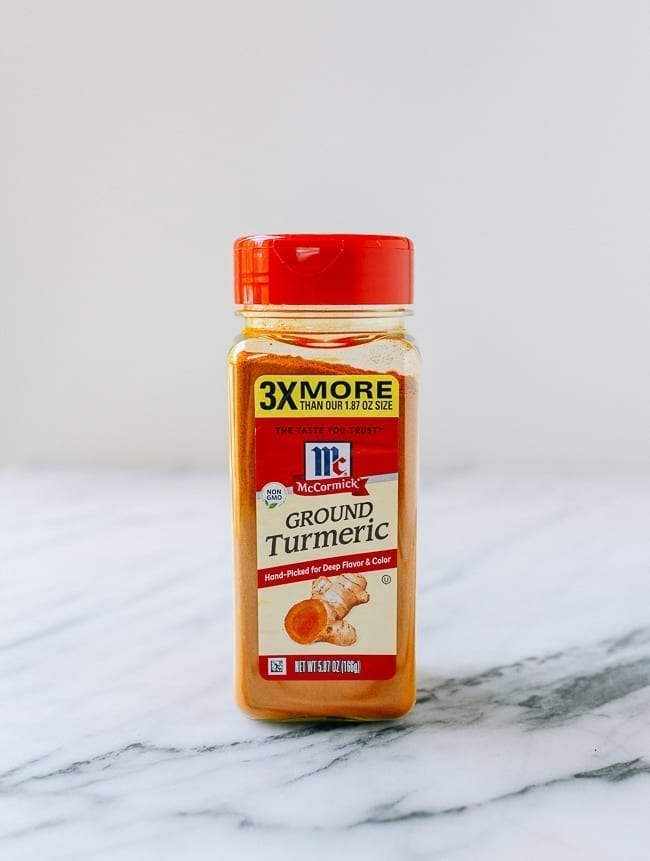
Turmeric powder, or huáng jiāng fěn (黄姜粉), is an essential ingredient in all curry powders, providing most of that yellow golden color! Adding extra turmeric powder enhances the color of a good curry dish, like our Instant Pot Curry Beef or Takeout Chicken Curry. It can also be used in place of food coloring when a nice yellow color is desired, like in our Chinese takeout classics, Egg Drop Soup and Chicken Egg Foo Young.
Ground Ginger powder (姜粉, jiāng fěn)
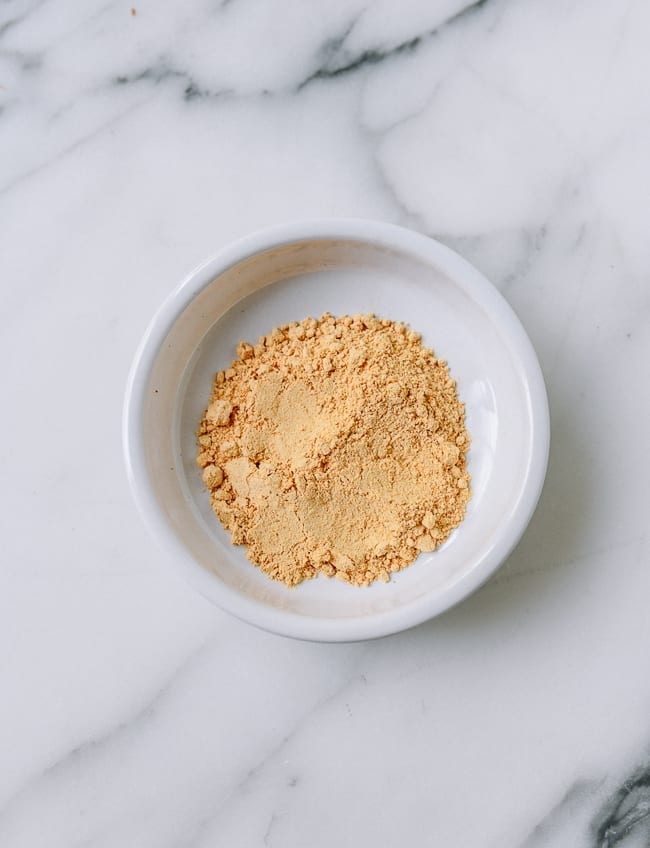
Ground ginger or ginger powder (jiāngfěn, 姜粉) is made by peeling, drying, and grinding the rhizome (the underground root-stem) of the ginger plant, formally known as zingiber officinale. The result is a fine, light yellow powder that has many applications as a spice. It isn’t often used in Chinese cooking beyond dry rub seasoning mixtures for marinating meats, but we do use it in baking applications like our Pumpkin Tres Leches Cake and Glazed Pumpkin Scones.
Galangal Root Powder (高良姜, GĀOLIÁNG JIĀNG)
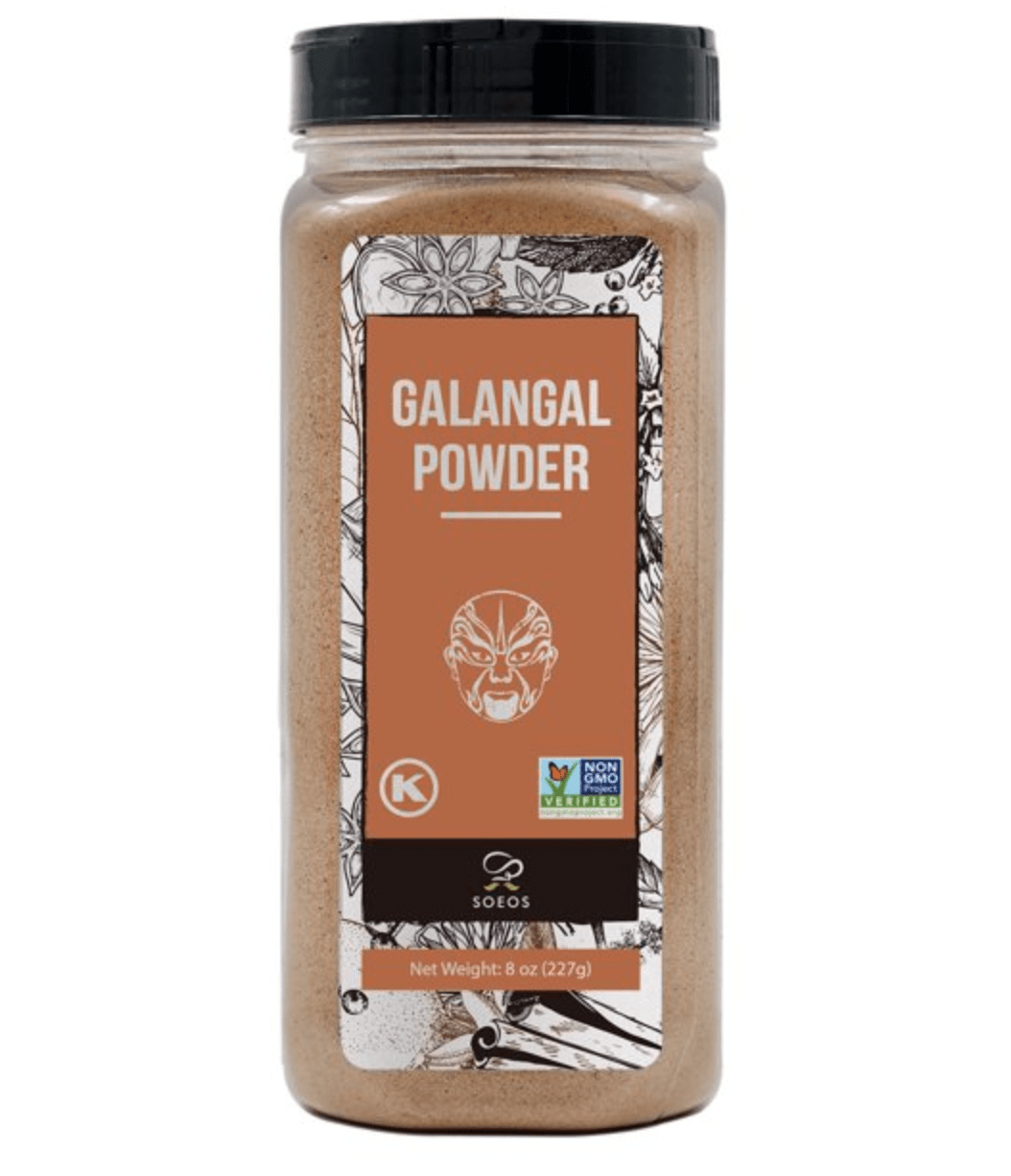
Galangal is used mostly in Southeast Asian cooking, and it’s sometimes referred to as Thai ginger. We use it fresh in Southeast Asian recipes, like our Thai Tom Yum Goong (Tom Yum Soup with shrimp) and our Indonesian / Malaysian Beef Rendang. In its dried, powdered form, we usually only use or recommend it as a replacement for powdered sand ginger (below), in spice rubs for chicken or pork.
Dried Sand Ginger (沙薑, shā jiāng)
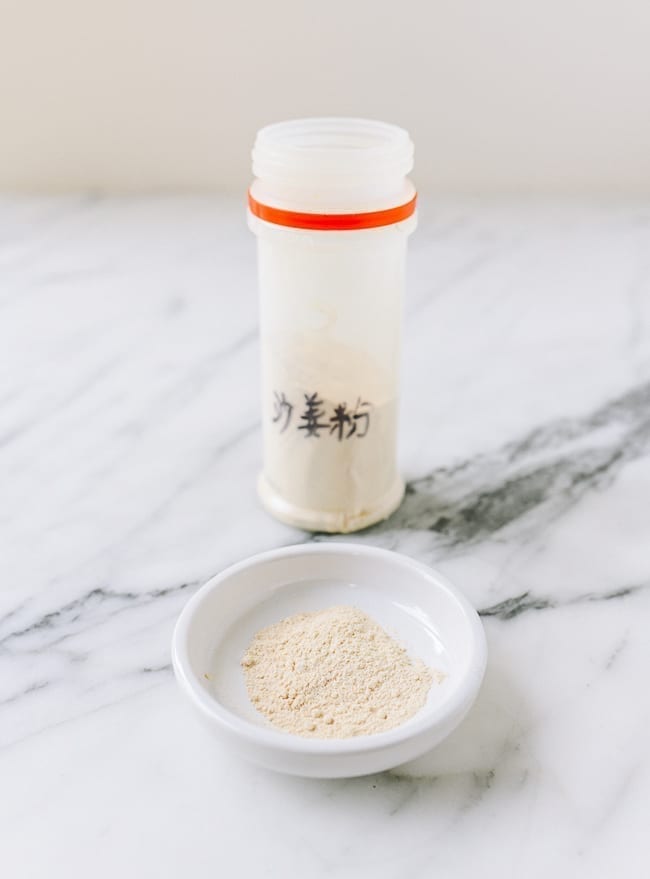
Dried Sand Ginger is different from regular ginger. In a side-by-side comparison of sand ginger powder or shā jiāng fěn (沙姜粉) with ginger powder (jiāng fěn – 姜粉), you’ll find that they taste and smell quite different. We mostly use sand ginger in its powdered form in dry spice rubs for chicken. You can also buy dried sand ginger slices from Chinese markets. English labeling for this ingredient can be inconsistent, so be sure to look for the Chinese characters, 沙姜粉, to ensure that you have the right one!
Dried Mandarin Orange Peel (果皮, Guǒpí)
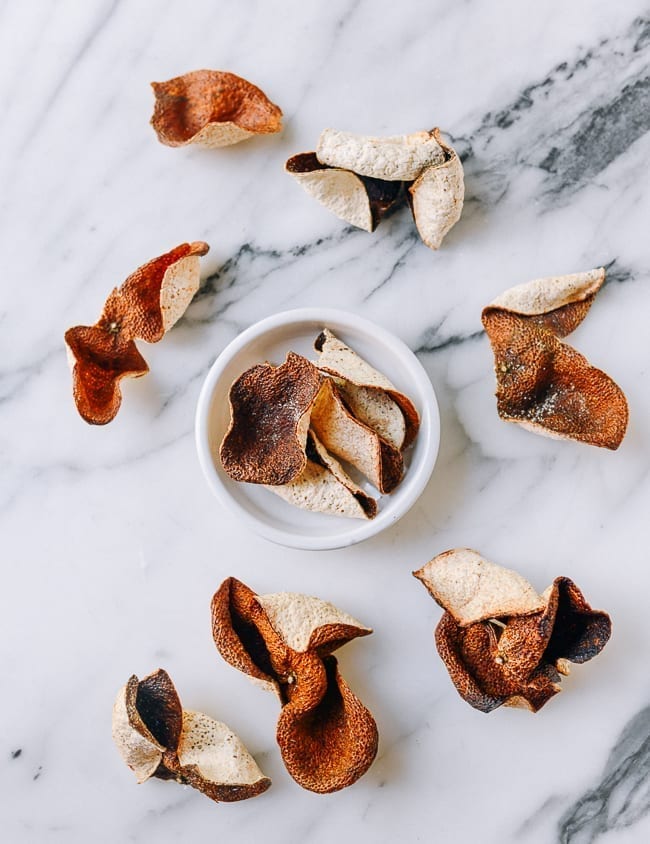
Dried mandarin orange peels, or guǒpí (果皮) in Chinese (which translates to “fruit skin”), are a widely used dried seasoning ingredient in Chinese cooking. We use it in dishes like Tangerine Beef and Orange Chicken, but also in soups, stews, and braised dishes like Braised Duck. In China, these oranges are grown not for their fruit, but specifically for their peel. You can try drying your own or buying it from your local Chinese grocery store.
Bay Leaves (香叶, xiāng yè)
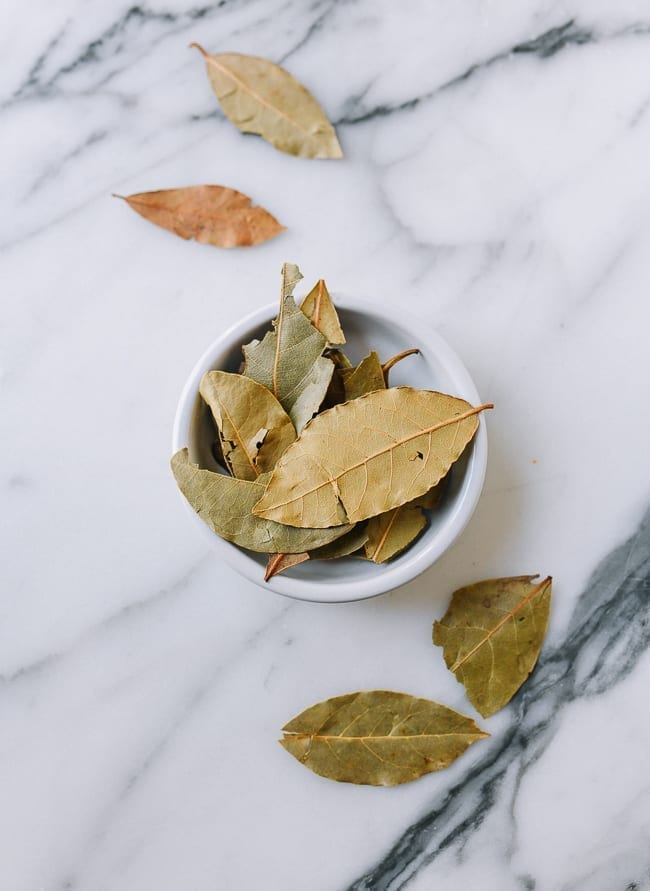
In Chinese cooking, whole dried bay leaves are often added to soups, stews, slow-cooked braised dishes (also known as lǔwèi – 卤味), and infused oils. The herbal flavor of the bay leaves is by no means the star of a recipe, but it definitely enhances the overall aroma and flavor of meat, vegetables, and sauces like chili oil. Bay leaves are used widely in many types of cooking. You can purchase dried bay leaves in the spice section of any grocery store, including Chinese markets!
Chinese Cinnamon (桂皮, guì pí)
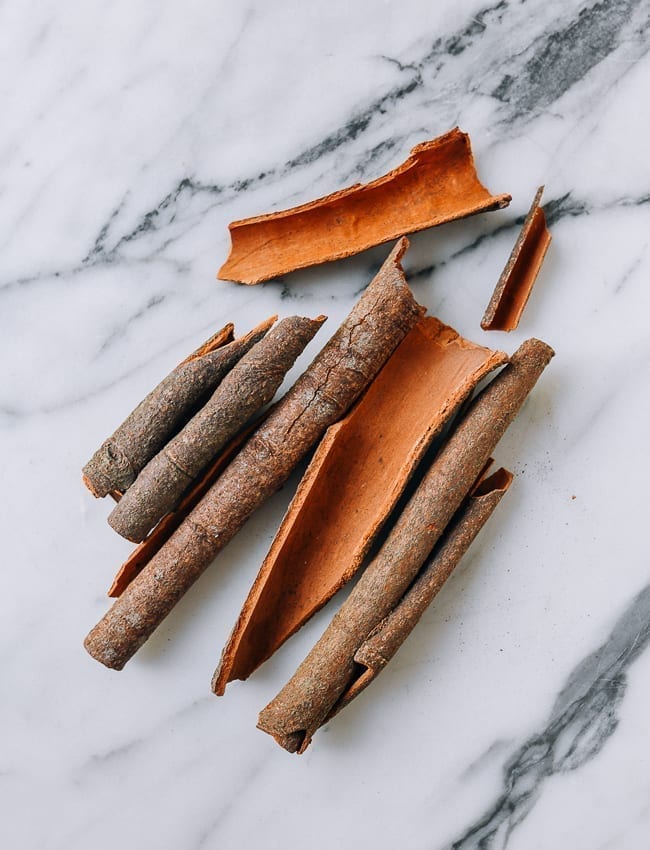
Also called cassia cinnamon, Chinese cinnamon or guì pí (桂皮), also known as ròu guì – 肉桂), is thicker and more bark-like than the cinnamon sticks you might be more familiar with. It’s one of the main ingredients in five-spice powder. In general, Chinese cinnamon sticks are less fragrant than regular cinnamon. While it’s more common in desserts in the West, it’s mostly used for savory braised dishes, stews, and marinades in Chinese cooking.
Chinese Licorice Root (甘草, Gāncǎo)
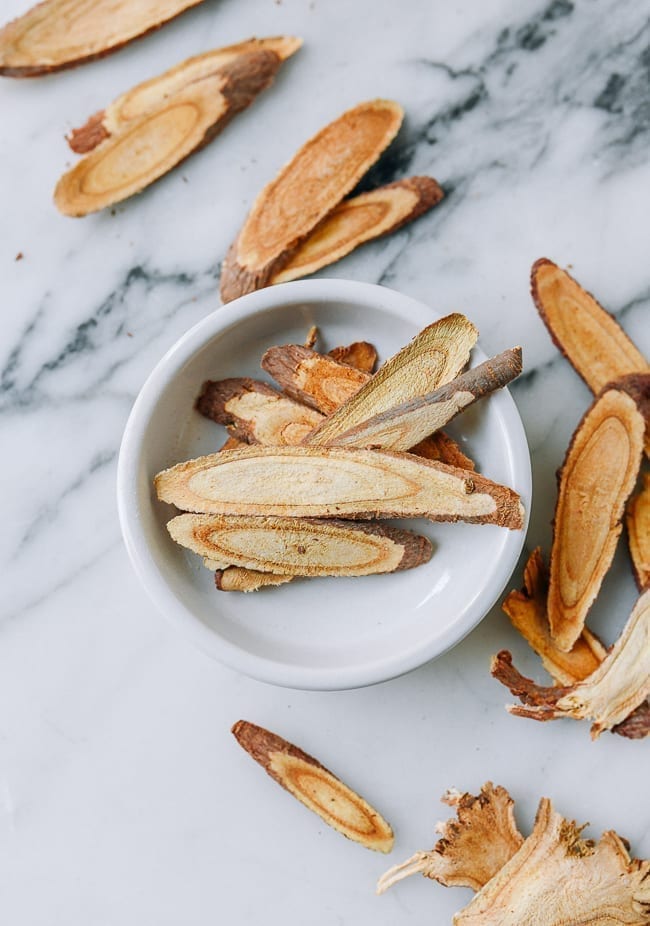
Chinese Licorice root is used in Chinese herbal medicine, as well as in cooking to flavor broths and braised dishes. The dried roots resemble small twigs with a woody brown exterior and pale yellowish interior. They are usually sold in thin slices that are cut on an angle to create lots of surface area. Many of you probably haven’t used it before, but we hope that the picture to the left helps you identify it at the store! Check out our Lanzhou Beef Noodle Soup (spicy) and Braised Beef Noodle Soup (红烧牛肉面) (not spicy).
Star Anise (八角, Bājiǎo)
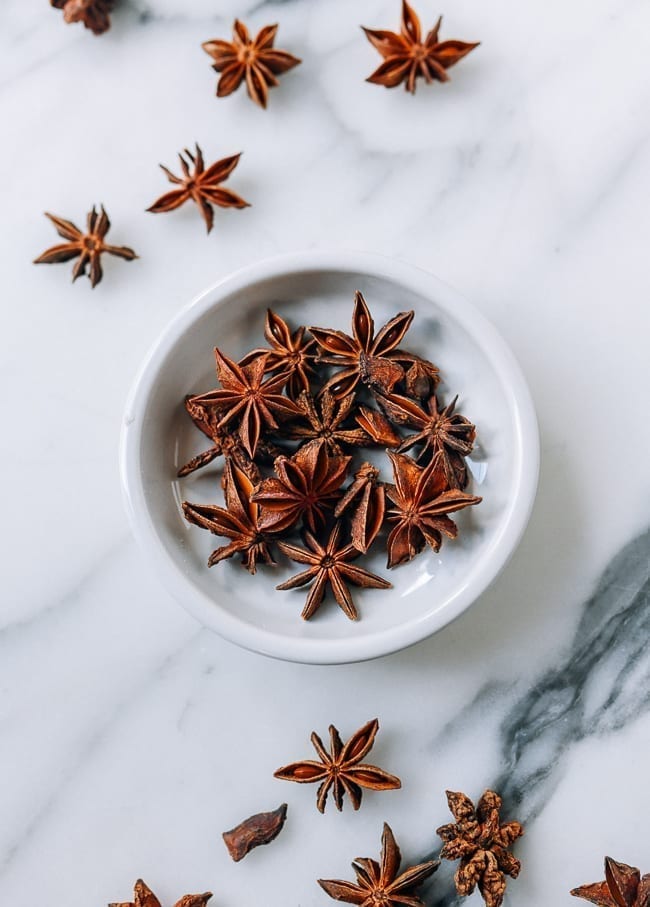
Star anise or ba jiao (八角) plays a key role in slow-cooked dishes and is also one of the spices in five spice powder. It has a powerful, licorice-like flavor and aroma that is slightly bitter, with a hint of sweetness. Look for whole pieces that aren’t broken up and store them it in a sealed container in your spice cabinet to keep them fresh. Star anise is an essential ingredient that provides a distinctive taste to dishes like Chinese Braised Oxtails, Soy Sauce Chicken and Lanzhou Beef Noodle soup, just to name a few.
Cloves (丁香, dīng xiāng)
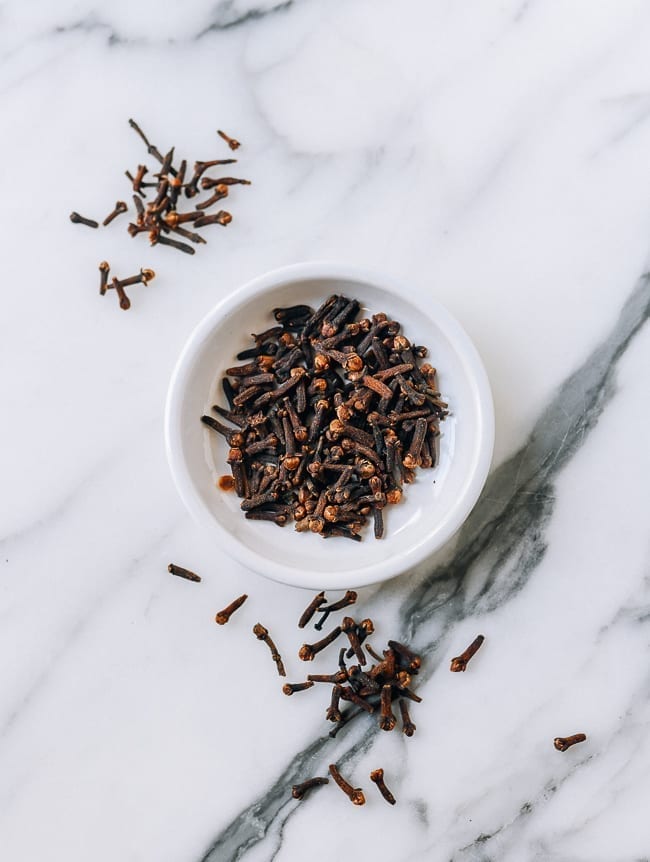
Cloves, or dīng xiāng (丁香), have a very strong, pungent, and sweet aroma. It is one of the five spices that make up five spice powder. It can be used whole or ground into a powder and is widely used in both Asian and Western cooking. We like to buy whole cloves and grind them as needed or just let whole cloves infuse recipes like Homemade Chili Oil. They also add great flavor to curry dishes like Beef Rendang.
Allspice
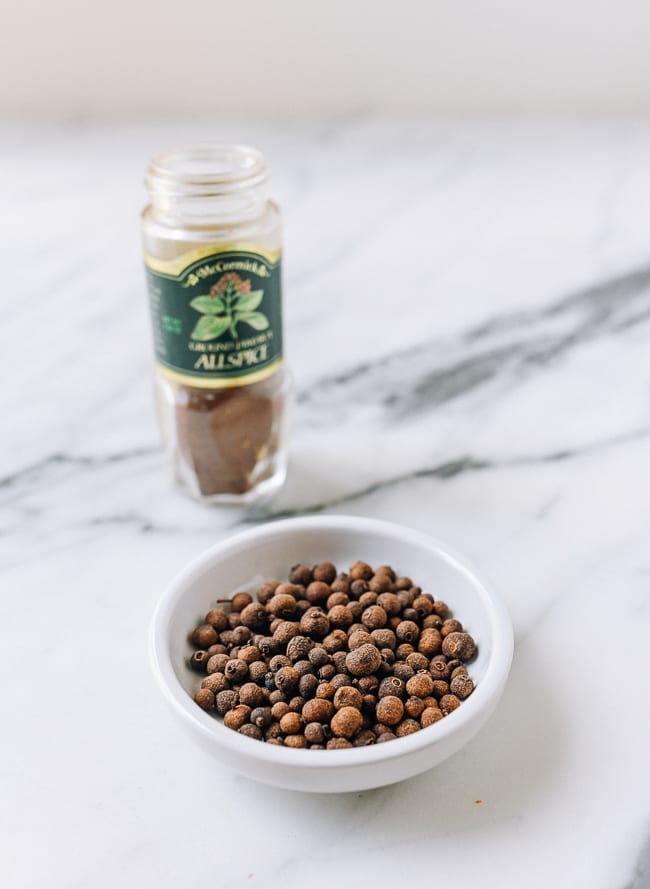
Allspice is sometimes confused with a mixture of spices, but in fact, it is the dried aromatic fruit of a West Indian tree. Sometimes called Jamaican pepper (it’s used extensively in Jamaican cuisine), it is sometimes used in Chinese cooking and incorporated into some traditional dishes like our Chinese New Year Sweet Rice Cake (Nian Gao). Read more about this spice’s origins and uses in our detailed allspice article.
Black Cardamom (草果, Cǎo guǒ)
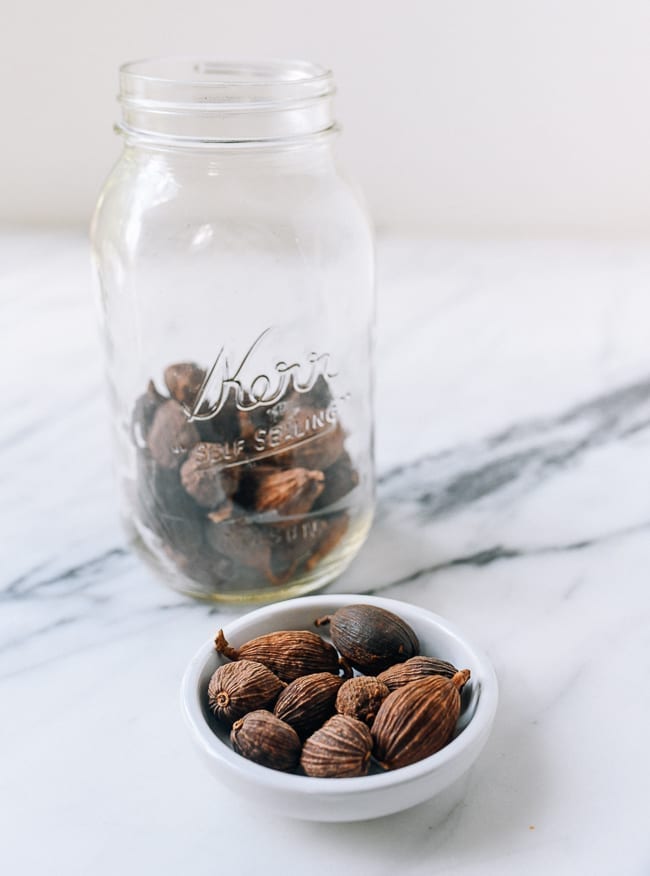
Black Cardamom, also known as tsaoko or cǎo guǒ (草果), is used extensively in Yunnan cuisine and some Southeast Asian cuisines. We have also seen black cardomom referred to as hēi dòukòu (黑豆蔻). It has a smoky fragrance and adds a complex dimension of flavor to stews and noodle soups like our Lanzhou Beef Noodle Soup and Pho Vietnamese Noodle Soup. Read more about it in our detailed black cardamom article.
Green Cardamom
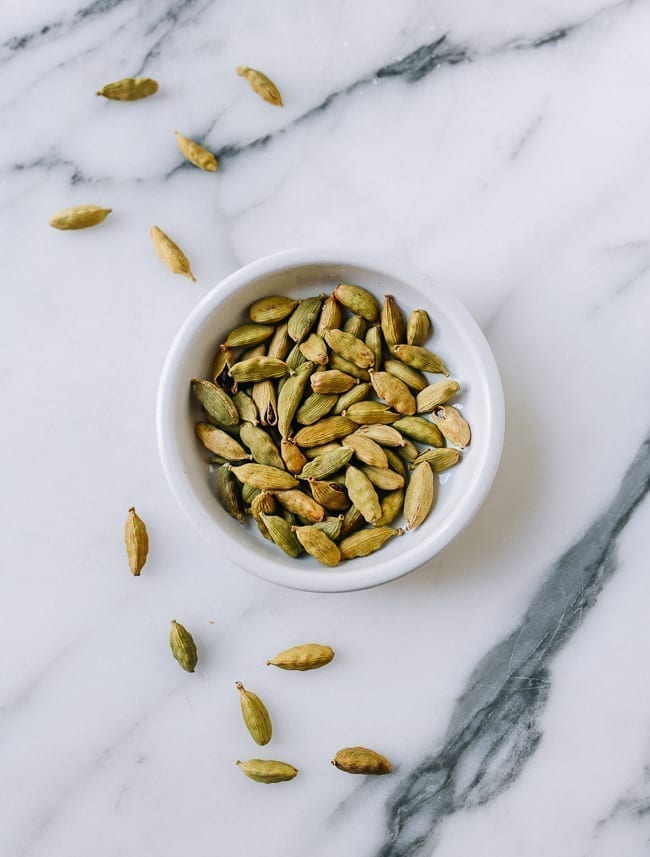
Green cardamom is a staple in Middle Eastern and Indian kitchens. Unlike black cardamom, green cardamom works as well in sweets as it does in savory dishes. You can use it in everything from sweet breads and cakes to curries. You may also see it in some Malaysian and Southeast Asian dishes due to Indian culinary influences in these areas. The whole pods may be used, but it’s also common to remove the seeds from the husk and grind them. A little goes a long way!
White Cardamom (白寇, Bái kòu)
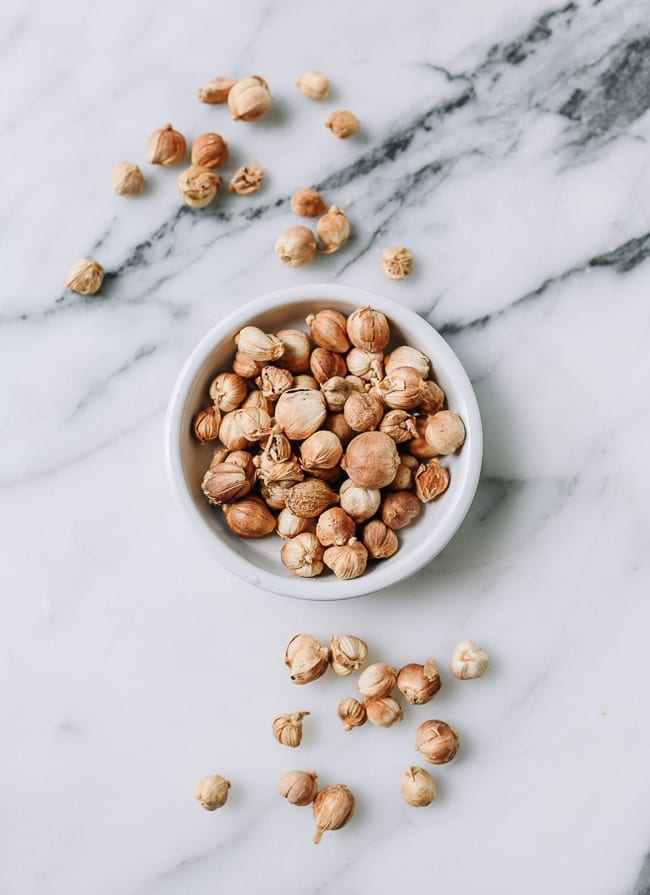
Amomum white cardamom is used throughout China and Southeast Asia for its floral and aromatic flavors. It is sometimes ground and used in spice blends, but we mostly use it whole in infused oils, braising liquids, and aromatic soups like Judy’s Braised Beef Noodle Soup (红烧牛肉面). It looks like a small dried chickpea, but it is in fact a soft pod with seeds inside. White cardamom has a hint of menthol flavor and does wonders for adding a unique flavor to your dishes.
Coriander seed (芫荽子, yán suī zi)
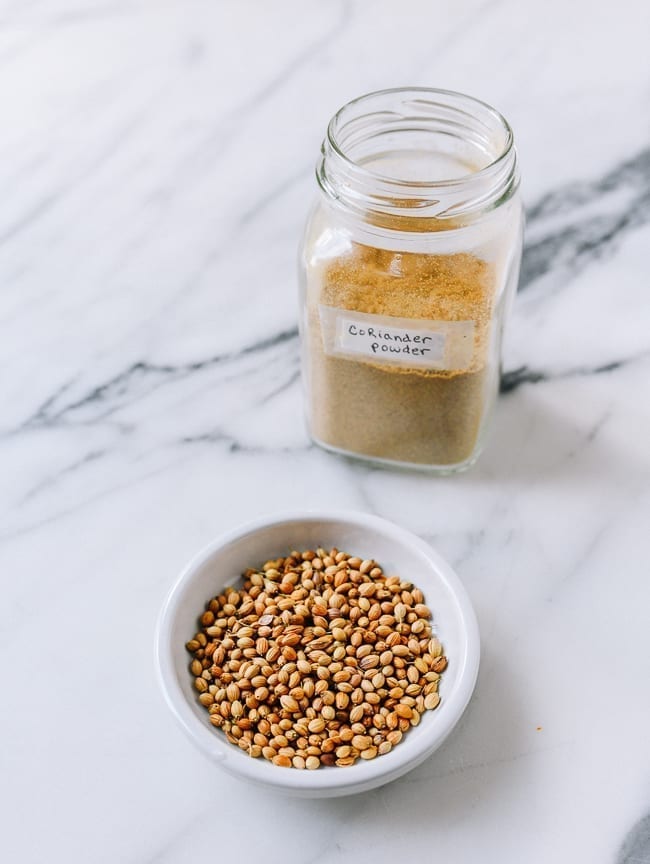
Fresh coriander or cilantro is used in many Chinese dishes. However, coriander seeds, or yán suī zi (芫荽子), aren’t used quite as often. That said, we do use them in dishes like our Biang Biang Noodles and Taiwanese Beef Noodle Soup. The zesty flavor and aroma of coriander complements many flavors without being overpowering. It often plays a supporting role in recipes that layer many spices for a rich and complex flavor profile.
Cumin Seed (孜然, zī rán)
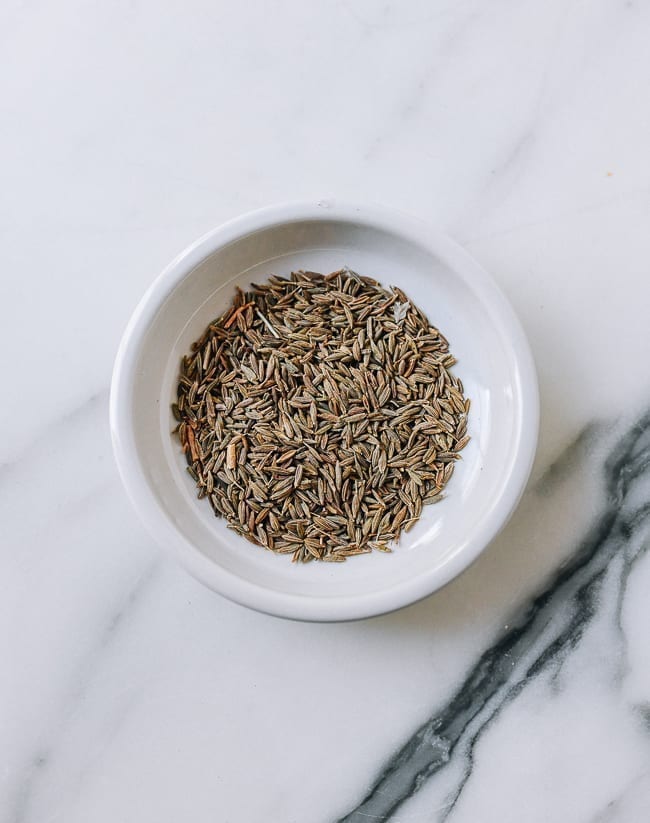
Cumin is an aromatic seed used to flavor sausages, rice, chutneys, and a variety of Indian, Asian, and Latin American dishes. We cook quite a few Latin American dishes, so cumin powder is always in our pantry. We also keep whole cumin seeds, since there are many Chinese dishes that call for it. Chinese recipes include our Beijing Lamb Skewers and Fried Chicken with Xinjiang Spices. Generally, you can find whole seeds at your local Indian or Asian grocery store.
Fennel Seed (茴香籽, huí xiāng zǐ)
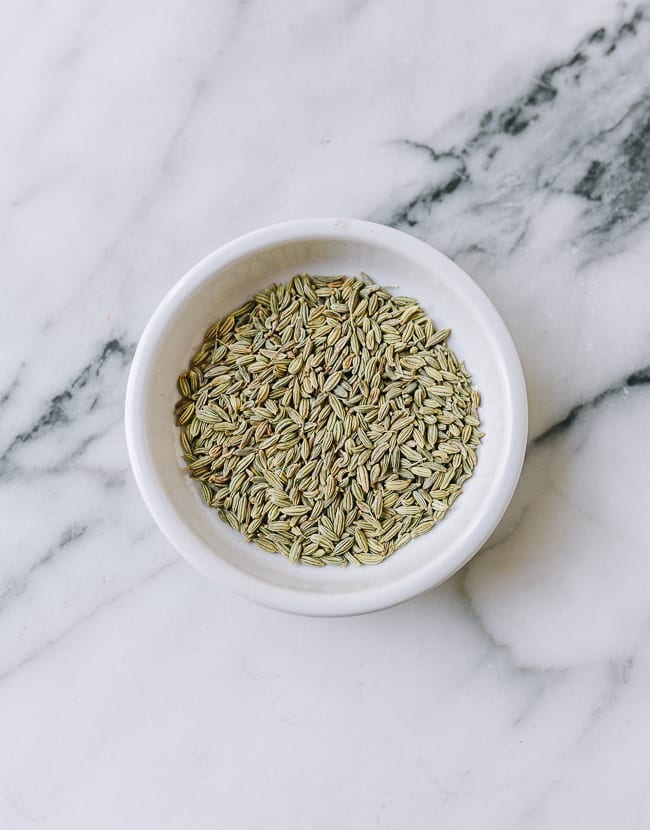
You are probably most familiar with the taste of fennel seeds in Italian sausages and in Indian cuisine, but they are also used in Chinese cooking! Fennel is one of the main spices used to make Chinese five spice powder. In our kitchen, we often pair fennel seed with other aromatic ingredients like star anise, cinnamon sticks, dried orange peel, and licorice root. Read more about it in our detailed article on fennel seed.
Sesame Seeds (芝麻, zhī ma)
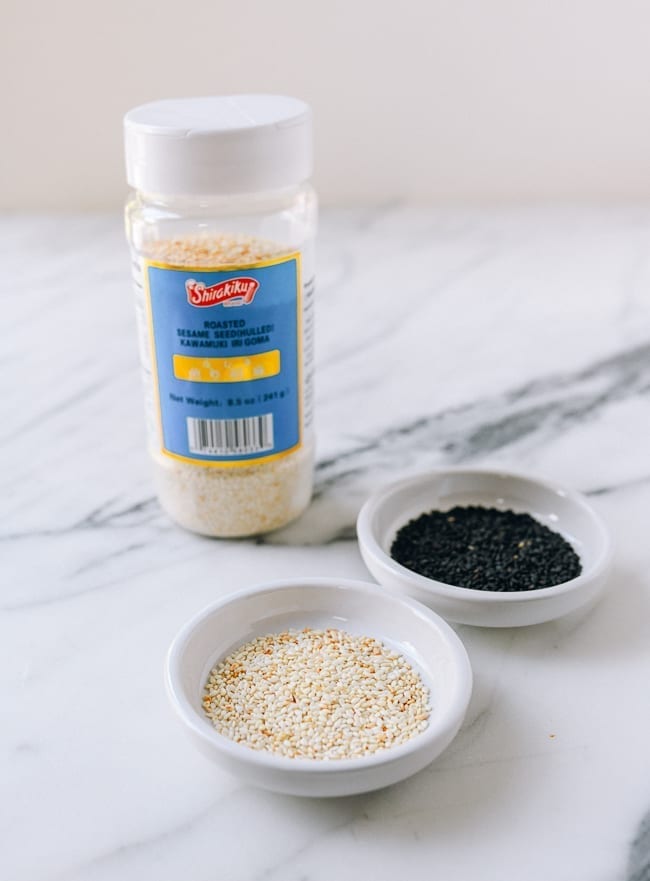
Sesame seeds or zhī ma (芝麻) are an essential pantry item for Chinese cooking. Sometimes used for sweet treats and sometimes for accent or garnish, they add a great nutty flavor and crunch. We use sesame seeds liberally in our kitchen. They’re the star of recipes like Sesame Balls, Sesame Twists, and Shanghai Scallion Flatbread. Both white and black seeds are used in Chinese cooking—whole as well as ground! Toasted and un-toasted seeds are readily available in Asian markets.
Chinese Spice Braising Packet (卤料包, Lǔ liào bāo)
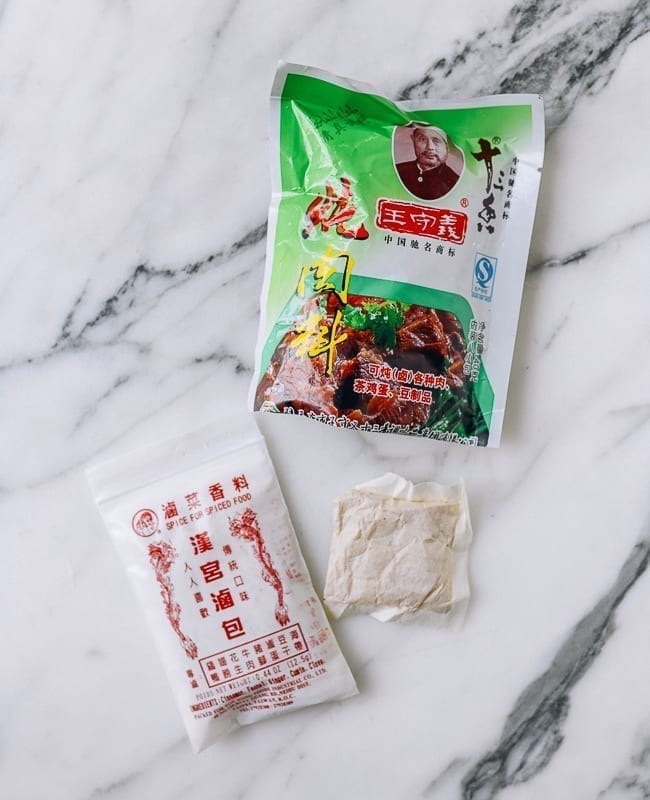
These are pre-measured packets of Chinese spices for making a braising liquid. “卤” generally refers to a spiced brine. Different brands have their own formulas, but spices usually include Chinese cinnamon, Sichuan peppercorn, star anise, cloves, dried tangerine peel, bay leaves, white pepper, dried licorice slices, and fennel. You can make your own, but with all those ingredients, you can see why people like the convenience of a ready-made pouch that works a lot like a tea bag!
Chinese salt baked chicken powder (盐焗鸡粉, Yán jú jī fěn)
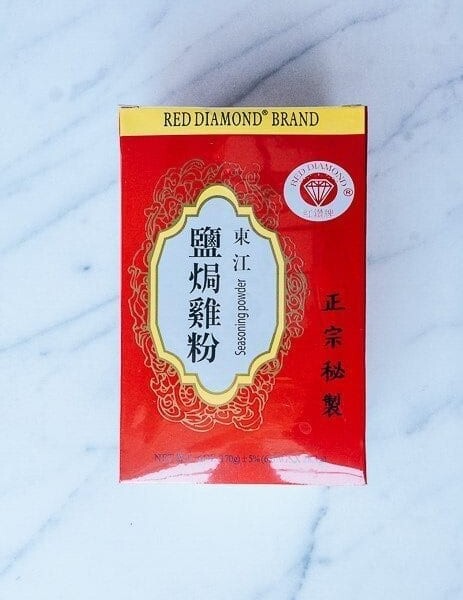
Salt Baked Chicken powder, or yán jú jī fěn (盐焗鸡粉) in Mandarin and yim gook gai fen in Cantonese, is a quick and easy way to marinate and make a classic Chinese salt-baked chicken. A key ingredient in this mixture is sand ginger powder (沙姜粉), which has its own unique taste. Judy has a Salt-Baked Chicken recipe that calls for all the necessary spices without the use of this ready-made packet, but we’ve included it here so you’re aware of this ingredient.
Steamed Meat Rice Powder (蒸肉粉, Zhēng ròufěn)
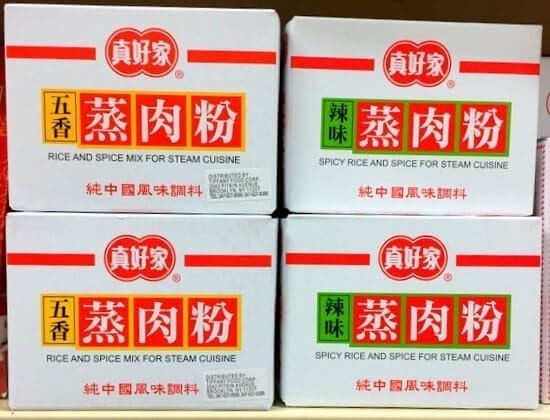
This ingredient is used in steamed meat (usually pork) dishes with rice powder, called fěnzhēngròu (粉蒸肉) in Mandarin. Meat is coated in seasoned toasted rice powder and steamed before serving. You can see how to make it from scratch in Judy’s Steamed Pork with Rice Powder (Fen Zheng Rou) recipe. The box in the photo on the left is a five spice flavor, and the one on the right is spicy.
our hand-picked pantry essentials—in one place!
We worked with Pearl River Mart, a family-owned Manhattan Chinatown institution in business since 1971, to collect our hand-picked pantry essentials (and some extras!) into this incredible Pantry Essential Friendship Box. These are the ingredients we use in our own kitchen. Get it shipped directly to you, and start cooking!
Get The Woks of Life x Pearl River Mart Pantry Essentials Friendship Box!
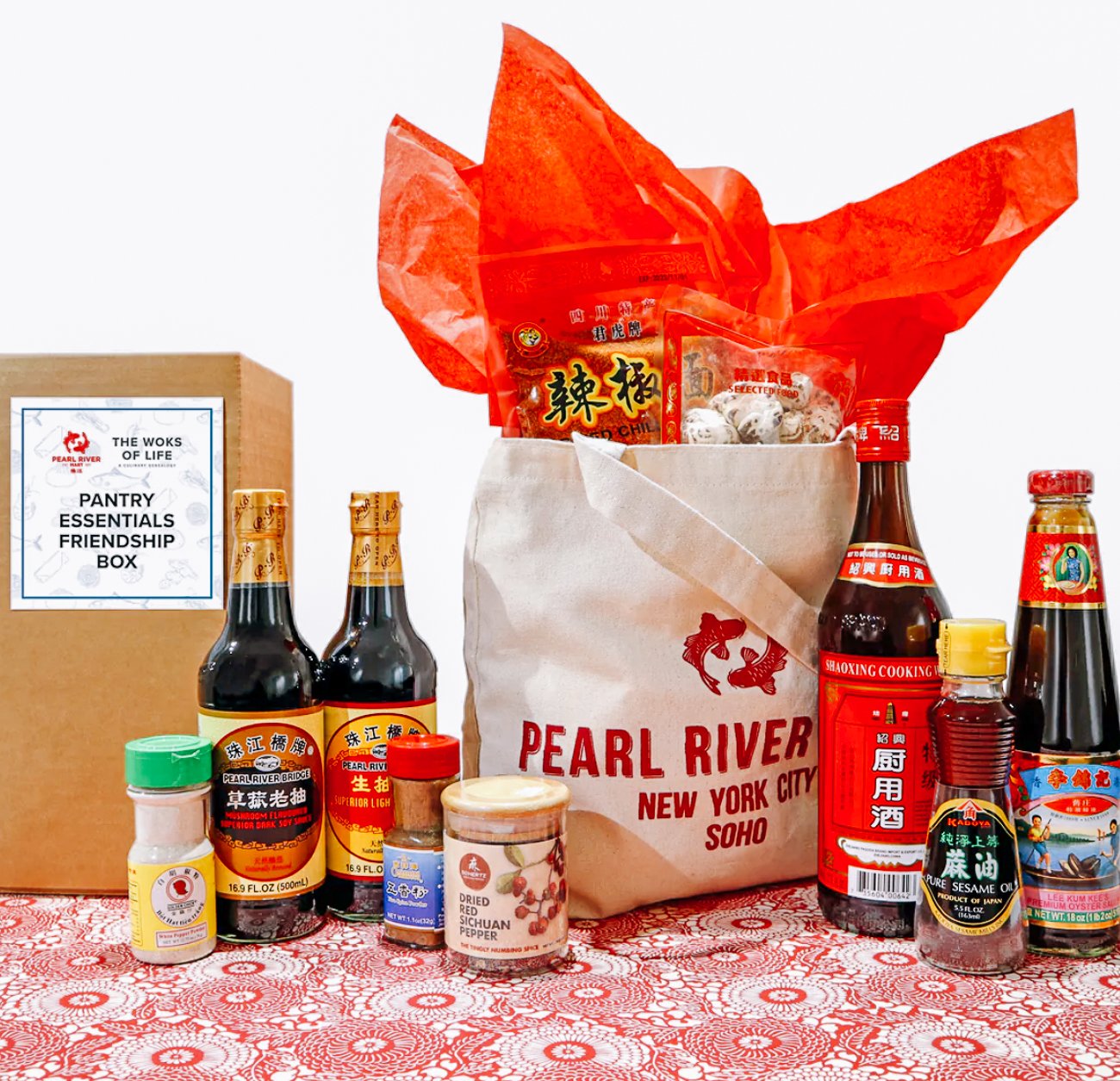
Wrap it up along with a copy of our cookbook for a unique wedding/wedding shower, holiday, birthday, or anytime gift! If you want to beef up the gift basket even more, Pearl River Mart sells woks, wok spatulas, and a plethora of other Chinese kitchen equipment! Check out our Chinese cooking tools page for ideas.